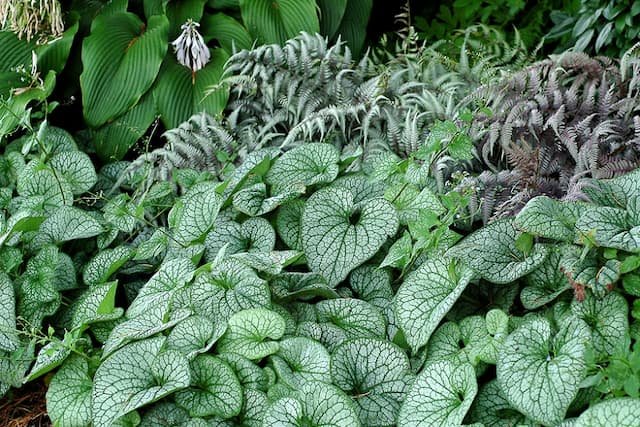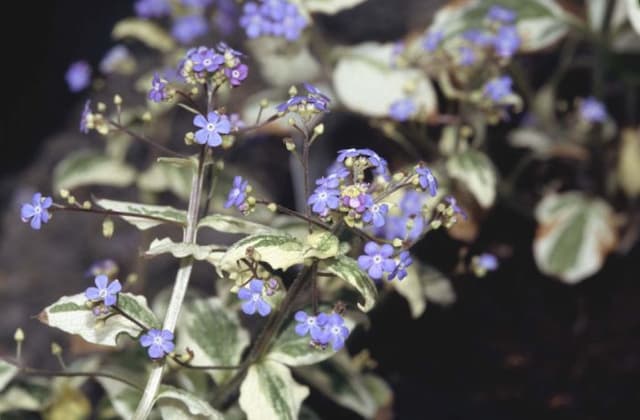Forget-me-not Myosotis sylvatica 'Ultramarine'

ABOUT
The Myosotis sylvatica 'Ultramarine', commonly known as the Wood Forget-Me-Not, is a charming perennial plant known for its vibrant blue flowers, which have a characteristic small and flat-faced shape with five petals that radiate around a central yellow eye. The petals have a delicate texture and are borne on airy, branching stems that rise above the foliage. The leaves of the Wood Forget-Me-Not are a medium green color; they are simple in form, with a slightly fuzzy texture that can be felt when touched. The foliage forms a basal rosette from which the flower stems emerge. Each flower cluster presents an enchanting, almost cloud-like appearance due to the profusion of blooms that cover the plant during its peak flowering season. The overall impression of the Myosotis sylvatica 'Ultramarine' is a delicate, cottage garden aesthetic, with a splash of vivid color that can enliven any garden space.
About this plant
 Names
NamesSynonyms
Woodland Forget-Me-Not, Garden Forget-Me-Not, Forest Forget-Me-Not, Sylvan Forget-Me-Not
Common names
Myosotis sylvatica 'Ultramarine'.
 Toxicity
ToxicityTo humans
The common name for Myosotis sylvatica 'Ultramarine' is Forget-me-not. Generally, Forget-me-nots are not considered poisonous to humans. They are not known to contain any toxic compounds that would cause serious harm if ingested in small quantities. However, ingesting any non-food plant can potentially cause mild stomach upset due to the plant material itself or possible pesticides used in cultivation. Eating Forget-me-nots is not advised, but accidental ingestion is unlikely to lead to serious poisoning or long-term health consequences.
To pets
The common name for Myosotis sylvatica 'Ultramarine' is Forget-me-not. Forget-me-nots are generally considered safe and non-toxic to pets such as dogs and cats. They do not contain known toxic substances that would cause severe poisoning if a pet were to ingest them. However, as with humans, consumption of plant matter can sometimes lead to mild gastrointestinal upset in pets due to plant material or potential chemicals on the plant. Overall, Forget-me-nots are not expected to cause serious health issues for pets if ingested in small amounts.
 Characteristics
CharacteristicsLife cycle
Biennials
Foliage type
Deciduous
Color of leaves
Green
Flower color
Blue
Height
0.5 feet (15 cm)
Spread
0.5 feet (15 cm)
Plant type
Herb
Hardiness zones
3
Native area
Europe
Benefits
 General Benefits
General Benefits- Attracts Pollinators: Myosotis sylvatica 'Ultramarine', commonly known as forget-me-not, is known to attract bees, butterflies, and other beneficial insects to the garden.
- Aesthetic Appeal: With its beautiful blue flowers, forget-me-not adds a splash of color and charm to garden beds, borders, and containers.
- Ease of Care: This plant is generally low-maintenance, making it suitable for gardeners of all skill levels.
- Ground Cover: Forget-me-nots can spread to form a carpet of flowers, providing an effective ground cover which helps to suppress weeds.
- Tolerance of Conditions: This species can tolerate a variety of conditions, thriving in both sun and partial shade, and is relatively resilient to different soil types.
- Companion Planting: Forget-me-nots can be planted alongside spring bulbs like tulips and daffodils, where they can complement these taller plants with their ground-level blooms.
- Ecological Support: They provide an early source of nectar in the spring, which is crucial for supporting the local ecosystem, particularly emerging pollinators.
- Self-Seeding: Forget-me-nots are self-seeding, which means they can reappear each year with no extra effort from the gardener.
- Seasonal Interest: They bloom in the spring, providing early seasonal interest in the garden when many other plants have yet to start growing.
- Historical and Cultural Significance: Forget-me-nots have a rich history in folklore and can bring a sense of tradition and storytelling to the garden.
 Medical Properties
Medical PropertiesThis plant is not used for medical purposes.
 Air-purifying Qualities
Air-purifying QualitiesThis plant is not specifically known for air purifying qualities.
 Other Uses
Other Uses- Photography enhancement: Forget-Me-Not's bright colors can be used to create visually appealing backgrounds or focal points in macro photography.
- Educational tool: Due to its ease of growth, Forget-Me-Not can be used to teach children about plant life cycles and gardening basics.
- Culinary garnish: The flowers of Forget-Me-Not are edible and can be used to add a decorative touch to salads and desserts.
- Dye production: The plant can be used to produce a natural blue dye for fabrics and crafting.
- Art supplies: Forget-Me-Not flowers can be pressed and included in paper making or used in botanical illustrations.
- Memory exercises: The name and the symbolism of the Forget-Me-Not can be used in memory games and exercises linking the flower to memorization techniques.
- Craft decoration: Dried Forget-Me-Not flowers can be used to embellish handmade cards or scrapbooks.
- Eco-friendly confetti: Dried petals of the Forget-Me-Not can be used as biodegradable confetti for weddings or other celebrations.
- Literary inspiration: The flower's symbolism is often utilized in poetry and literature, serving as a muse for writers.
- Cultural studies: Forget-Me-Not can be a subject for studying the significance of flowers in various cultures and historical contexts.
Interesting Facts
 Feng Shui
Feng ShuiThe Forget-me-not is not used in Feng Shui practice.
 Zodiac Sign Compitability
Zodiac Sign CompitabilityThe Forget-me-not is not used in astrology practice.
 Plant Symbolism
Plant Symbolism- True Love: "Forget-me-nots," as they are commonly called, symbolize true love and enduring memories, suggesting a connection that lasts despite distance or time apart.
- Remembrance: The name itself, "Forget-me-not," implores not to forget the giver, making it a symbol of remembrance and memory.
- Faithfulness: These flowers are often associated with fidelity and faithfulness in relationships, due to their lasting nature.
- Loyalty: Echoing the themes of faithfulness, forget-me-nots represent loyalty, a commitment that does not waver.
- Hope: The delicate appearance of the flower juxtaposed against its hardy nature makes it a symbol of hope amidst adversity.
 Water
WaterForget-me-nots prefer consistently moist soil, so it's essential to water them regularly. During the growing season, water them with about 1 inch of water per week, either through rainfall or manual watering. During hot or dry spells, you may need to water them twice a week to maintain soil moisture. It is best to water at the base of the plants to keep the foliage dry and prevent fungal diseases. Adjust watering if rainfall provides sufficient moisture, and reduce watering in the fall as the plant goes dormant.
 Light
LightForget-me-nots thrive in conditions with partial shade to full sun. They perform best when they receive morning sunlight and are protected from the harsh afternoon sun, especially in warmer climates. An ideal spot would be under a tree where they can get dappled sunlight or in an area that receives sunlight for part of the day but is shaded during the hottest period.
 Temperature
TemperatureForget-me-nots grow well in a wide range of temperatures but prefer cooler climates. They can tolerate minimum temperatures down to about 20 degrees Fahrenheit but they thrive in temperatures between 60-70 degrees Fahrenheit. Extreme heat above 85 degrees Fahrenheit can stress the plants, so providing some afternoon shade in hot climates is beneficial to keep them cool.
 Pruning
PruningForget-me-nots benefit from deadheading, which is the removal of spent flowers to encourage continuous blooming. Prune them by pinching off the faded flowers throughout the blooming season to maintain a tidy appearance and stimulate new growth. After the primary bloom period in late spring or early summer, cut back the stems by one-third to rejuvenate the plants and possibly encourage a second flush of flowers. The best time for pruning is immediately after the first wave of blooming has subsided.
 Cleaning
CleaningAs needed
 Soil
SoilForget-me-nots thrive in moist, well-draining soil enriched with organic matter. A mixture of peat, perlite, and garden soil, with an added slow-release fertilizer, would be ideal. They prefer a slightly acidic to neutral pH, around 5.5 to 7.0.
 Repotting
RepottingForget-me-nots (Myosotis sylvatica 'Ultramarine') do not typically require frequent repotting and can often be treated as annuals. If they are kept as perennials, repotting every 2-3 years is sufficient to refresh the soil.
 Humidity & Misting
Humidity & MistingForget-me-nots prefer a moderate to high humidity level but are adaptable to natural outdoor conditions. Ideal humidity is around 60-70% for optimal growth.
 Suitable locations
Suitable locationsIndoor
Place in well-lit space, keep soil moist, moderate humidity.
Outdoor
Plant in partial shade, moist soil, protect from afternoon sun.
Hardiness zone
3-8 USDA
 Life cycle
Life cycleMyosotis sylvatica 'Ultramarine', commonly known as the Woodland Forget-Me-Not, begins its life cycle as a seed which germinates in cool, moist conditions in spring. After sprouting, the plant enters a vegetative stage, growing a rosette of basal leaves and developing a root system. As temperatures rise, it develops a flowering stalk that bears small, bright blue flowers with yellow centers, typically blooming between late spring and early summer. After pollination, which is often aided by insects, the plant sets seed within tiny nutlets. The seeds disperse in late summer or fall, dropping to the ground where they can lie dormant until the following spring. The plant is biennial or a short-lived perennial, often completing its life cycle within two years, after which it dies back, having self-seeded to produce the next generation.
 Propogation
PropogationPropogation time
Spring to early summer
The most popular method to propagate Forget-me-nots (Myosotis sylvatica 'Ultramarine') is through seed sowing. This is typically done in late spring or early summer after the danger of frost has passed. To propagate, scatter the seeds lightly on the surface of a well-drained soil mix in a shaded area or in seed trays. Since Forget-me-not seeds need light to germinate, they should not be covered with soil but can be gently pressed into the surface to ensure good contact. Keep the soil moist but not waterlogged. Seedlings usually appear within 14 to 21 days but may take longer if conditions are not ideal. Once the seedlings have grown large enough to handle, they can be transplanted into their final positions, spaced about 8 inches (20 centimeters) apart.









